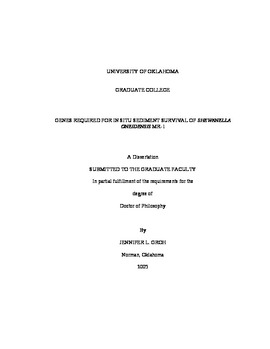| dc.contributor.advisor | Krumholz, Lee R., | en_US |
| dc.contributor.author | Groh, Jennifer L. | en_US |
| dc.date.accessioned | 2013-08-16T12:19:58Z | |
| dc.date.available | 2013-08-16T12:19:58Z | |
| dc.date.issued | 2005 | en_US |
| dc.identifier.uri | https://hdl.handle.net/11244/951 | |
| dc.description.abstract | We determined the function of one sediment-survival gene, examining mexF in greater detail. The protein encoded by mexF shares high homology with MexF in pathogenic Pseudomonas where it has been shown to confer a multidrug resistance phenotype on its host. We determined that mexF in MR-1 also functions in multidrug resistance, although additional substrates, including those that may be found in sediment remain to be elucidated. We propose that similar genes, present in the genomes of both pathogenic and nonpathogenic bacteria, have persisted over time in order to combat natural (such as plant- and bacterial-derived antimicrobials) as well as man-made toxins. | en_US |
| dc.description.abstract | We developed a modified version of the traditional signature-tagged mutagenesis (STM) procedure, incorporating microarray technology to streamline the entire screening process. We also identified a mini-Tn10 transposon that is capable of randomly mutagenizing model bacteria of the gamma- and delta- Proteobacteria. This system can therefore be applied to a wide variety of environmentally significant bacteria to answer questions of ecological or economical importance. This is the first study to use STM in studying bacteria of environmental significance. | en_US |
| dc.description.abstract | We identified 47 genes required for sediment survival of MR-1. We validate our STM screening method by identifying genes that would be expected to enhance sediment survival (e.g., chemotaxis genes) or would be required for growth with Fe(III) (i.e., gspN, a gene within an operon that was shown previously to be required for Fe(III) reduction). We describe the putative sediment functions of many groups of these genes, and we propose roles for phage- and transposon-related genes, as well as many genes involved in defensive mechanisms, such as multidrug resistance. | en_US |
| dc.description.abstract | We examined survival of Shewanella oneidensis MR-1 in sediment microcosms under various respiratory conditions. MR-1 was able to maintain its population in aerobic, transitory, and unamended anaerobic sediments; however, under Fe(III)-reducing conditions, the addition of lactate or an electron shuttle/Fe(III) chelator was required for maintenance of inoculum concentration and for growth in some instances. Loss of numbers in the absence of these compounds may result from direct competition with indigenous bacteria, such as Geobacter species, that are better suited physiologically for obtaining energy from Fe(III) reduction. | en_US |
| dc.format.extent | xviii, 169 leaves : | en_US |
| dc.subject | Mutagenesis. | en_US |
| dc.subject | Biology, Microbiology. | en_US |
| dc.subject | Bioremediation. | en_US |
| dc.subject | Shewanella. | en_US |
| dc.title | Genes required for in situ sediment survival of Shewanella oneidensis MR-1. | en_US |
| dc.type | Thesis | en_US |
| dc.thesis.degree | Ph.D. | en_US |
| dc.thesis.degreeDiscipline | Department of Microbiology and Plant Biology | en_US |
| dc.note | Adviser: Lee R. Krumholz. | en_US |
| dc.note | Source: Dissertation Abstracts International, Volume: 66-12, Section: B, page: 6412. | en_US |
| ou.identifier | (UMI)AAI3203311 | en_US |
| ou.group | College of Arts and Sciences::Department of Microbiology and Plant Biology | |
